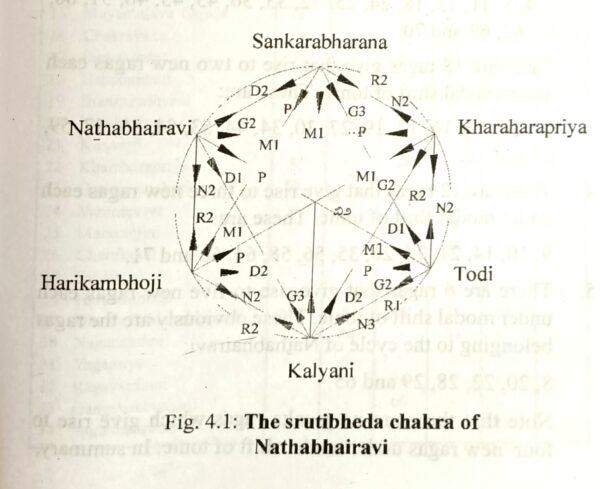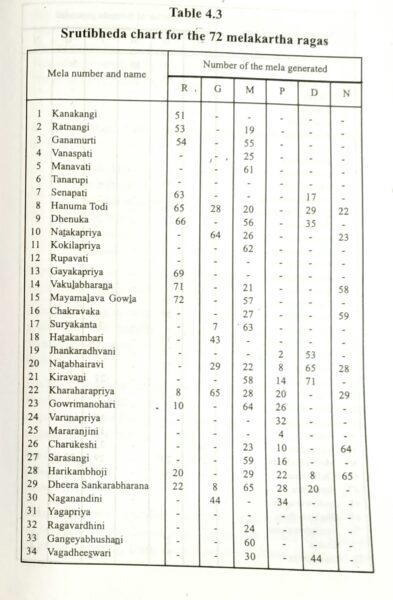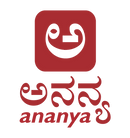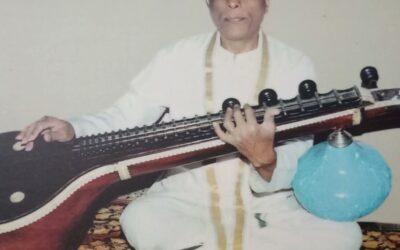Chapter 4 (Contd)
APPLICATION OF SRUTIBHEDA TO JANAKA RAGAS
– Dr. K Varadarangan
Where samyukthaksharas or conjunet consonants figure in this katapayadi prefixes, the rule is that the second or last component letter of the conjunct consonant (i.e. the consonant immediately preceding the vowel) should be taken into consideration. Thus in Ratnangi, Suryakanta, Jhankaradhwani, Gangeyabhushani, Shadvidhamargini, Shanmukhapriya, Dharmavati and Kantamani, the correct serial numbers are obtained in this manner. Thus the letter ‘na’ in Ratangi, the letter ‘ya’ in Suryakanta, the letter ‘ka’ in Jhankaradhwani, the letter ‘ga’ in Gangeyabhushani, the letter ‘va’ in Shadvidhamargini, the letter ‘ma’ in Shanmukhapriya, the letter ‘ma’ in Dharmavati and the letter ‘ta’ in Kantamani are to be considered.
But in the case of the following melas—Chakravaka, Divyamani, Visvambhari, Syamalangi, Simhendramadhyama, Chitrambari and Jyotiswarupini, the first component letter of the conjunct consonant concerned has to be taken in order that the application of the katapayadi sutra might give the correct serial number. Thus these melas constitute an exception to the general katapayadi sutra. Thus ‘ka’ in Chakravaka, ‘va’ in Divyamani, ‘sa’ in Visvambhari, ‘sa’ ( for the first letter in the raga) are to be considered.
The katapayadi prefixes are the key syllables for determining the serial number of the melas. They are also called the sankhyaksaras. Since the application of the katapayadi sutra is confined to consonants, the mela names have in begin with consonants and not vowels.
4.4 Finding the scale of the mela from its serial number.
Let n denote the serial number of the mela under consideration. Divide this number by 6. Let the quotient be designated by p and the remainder by q. Then the raga belongs to the (p+1)th chakra and the serial number of the raga in that chakra will be q. If the remainder is zero, then the raga will be last (6th )raga in the pth chakra. For example, if the serial number of the mela is 28, we get upon dividing this number by 6, p=4 and q=4. Hence the raga belongs to the fifth chakra and it is the fourth raga in the chakra. The fifth chakra has suddha madhyama and the swara combinations R2,G3. As this raga is the fourth raga in the chakra, it has got the swaras D2, N2. Hence the scale of the raga is S R2 G3 M1 P D2 N2 S. As already seen, this raga is the well known mela Harikambhoji.
4.5 Srutibheda possibilities of janaka ragas
It is quite easy to determine the srutibheda possibilities of ragas mathematically. It may be noted that the srutibedha process is essentially a process of division, dividing the relative frequencies of the swaras of a scale by that of the moorchana swara gives the new scale. In this process, the moorchana swara of the starting scale becomes the adhara shadja of the new scale. (In the cents system, the process of srutibheda becomes essentially a process of subtraction. Subtracting the relative frequency of the moorchana swara from the relative frequencies of the swaras of the scale gives the new scale.)
Conventionally, the effect of srutibheda on a given raga is determined in a practical way by either singing or playing. However, this entails expertise on the part of the person performing the srutibedha. It also demands a high level of mental concentration when srutibheda possibilities of ragas are determined this way. Determining the srutibheda possibilities of a large number of ragas requires an enormous amount of time. Another difficulty is in determining the degree of accuracy of the notes that are produced after the tonic shift.
4.5.1 Determination of srutibeda possibilities using a computer
The srutibheda possibilities of ragas can be determined easily and speedily using computer. In order to do this the srutibheda process should be defined as a computer program. No human judgment is involved in this process as it is automated. There are several other advantages as well, the frequencies resulting from the process of tonic shift can be determined accurately and thus we would know if there are any deviations from the ideal values. Another advantage is that the names of the scales may be stored as a database and using this, the computer can automatically pick up the names of the resulting scales and display them. This is particularly helpful when srutibheda possibilities for a large number of ragas are to be determined.
4.5.2 Moorchanas of janaka ragas
Starting from the scale of a given janaka raga and a moorchana swara, one can determine the resulting sequence of swaras when modal shift of tonic is applied. However, the resulting sequence of swaras may not form a meaningful scale of a janaka raga. This can happen due to reasons listed below:
- There may be two madhyama swarasthnas, one next to the other.
- There may be one gandhara swarasthana next to two rishabha swarasthanas.
- There may be two gandhara swarasthanas next to a rishabha swarasthana.
- There may be one nishada swarasthana next to two dhaivatha swarasthanas.
- There may be two nishada swarasthanas next to a dhaivatha swarasthana.
Thus in all cases shown above no meaningful raga results due to modal shift of tonic.
In the case of janaka ragas, Nathabhairavi gives the maximum number of output ragas when srutibheda is performed in this case, no new raga results from the rishabha moorchana as this leads to two madhyamas in the output scale. (This is commonly called as the chyuta panchama dosha. A prati madhyama next to a suddha madhyama is called as the chyuta panchama.) However, as seen already, from gandhara we get Sankarabharana, from madhyama we get Kharaharapriya, from panchama Todi, from dhiavata Kalayani and from nishada, we get Harikambhoji thus producing 5 new ragas. The sruthibheda chakra of this raga is shown in Fig 4.1. It consists of 6 ragas and has the distinction of having the highest number of ragas in a srutibheda chakra. In other ragas only some of the moorchana swaras give rise to new ragas. There are soma ragas in which none of the swaras give rise to any new raga. Such ragas are called amoorchanakaraka ragas.

Table 4.3 summaries the srutibheda possibilities of all the 72 melakarta ragas. This list is derived from a computer program called sbedha.exe. Description of this program is given as an appendix to this book. As mentioned already, srutibheda is performed assuming the frequency ratios of the 12 swaras shown in Table 3.2. The results of this table tally perfectly with that presented in earlier works ( see South Indian Music, Vol.V, Chapter 5, pages 86-87, by Sambamurthy).
4.5.3 Observations
1) Out of the 72 melas, 56 ragas give rise to at least one new raga under modal shift of tonic. The remaining 16 ragas (6,12,31,37,42,50,52,67,68) are amoorchanakaraka melas.
2) Out of these 56 ragas, 20 give rise to only one new raga under modal shift of tonic. These are : 1,4,5,11,13,18,24,25,32,33,36,43,45,46,51,60,61,62,69,and 70
3) There are 18 ragas give that rise to two new ragas each under modal shift of tonic. These are: 2,3,7,15,16,17,19,27,30,34,44,53,54,55,57,59,63 and 72
4) There are 12 ragas that give rise to three new ragas each under modal shift of tonic. These are : 9,10,14,21,23,26,35,56,58,64,66 and 71
5) There 6 ragas that give rise to five new ragas each under modal shift of tonic. These obviously are the ragas belonging to the cycle of Nathabhairavi: 8,20,22,28,29 and 65
Note that there are no janaka ragas which give rise to four new ragas under modal shift of tonic. In summary,
No. of ragas that give rise to only one new raga – 20
No of ragas that give rise to two new ragas each -18
No of ragas that give rise to three new ragas each -12
No of ragas that give rise to five new ragas each – 6
No of amoorchanakaraka ragas – 16
Total – 72

Table 4.3 contd

6) The number of new moorchanas arising from each swara is as follows:
Rishabha 17
Gandhara 20
Suddha madhyama 24
Panchama 24
Dhaivata 20
Nishada 17
Note that the swara prati madhyama does not give rise any raga under modal shift of tonic.
It is interesting to note that the number of moorchanas of both panchama and suddha madhyama is same. (Both of these swaras give rise to 24 ragas each.) The reason for this is as follows:
Under the madhyama moorchana of a given base raga, the tara shadja takes the place of the swara panchama of the resulting raga. This means that the panchama moorchana of the resulting raga gives back the base raga as illustrated below:
Base raga S R G M P D N1 Ṡ Ṙ Ġ Ṁ Ṗ
Moorchana of Suddha madhyama – – – S R G M P D N Ṡ Ṙ
Thus, for every suddha madyama moorchana there is a corresponding panchama moorchana and hence the number of ragas resulting from these two moorchana swaras is the same.
Likewise, the number of moorchanas of both rishabha and nishada is the same. (Both of these swaras give rise to 17 ragas each.) The reason for this is follows:
Under the rishabha moorchana of a given base raga, the tara shadja of the base raga takes the place of the swara nishada of the resulting raga. This means that the nishada moorchana of the resulting raga gives back the base raga as illustrated below :
Base raga S R G M P D N Ṡ Ṙ Ġ Ṁ Ṗ
Moorchana of Rishabha – – – S R G M P D N Ṡ Ṙ
Thus for every rishabha moorchana there is a corresponding nishada moorchana and hence the number of ragas resulting from these two moorchana swaras is the same.
Similarly, the number of moorchanas of both gandhara and dhaivata is same. (Both of these swaras give rise to 20 ragas each.) Under the gandhara moorchana of a given base raga, the tara shadja of the base raga takes the place of the swara dhaivata of the resulting raga. This means that the dhaivatha moorchana of the resulting raga gives back the base raga as illustrated below:
Base raga S R G M P D N Ṡ Ṙ Ġ Ṁ Ṗ
Moorchana of Gandhara – – S R G M P D N Ṡ Ṙ
Thus, for every gandhara moorchana there is a corresponding dhaivata moorchana and hence the number of ragas resulting from these two moorchana swaras is the same.
7) Sankarabharana is the only mela whose madhyama moorchana gives rise to its corresponding prati madhyama mela. Mechakalyani. Likewise, Mechakalyani is the only mela whose panchama moorchana gives rise to its corresponding suddha madhyama mela Sankarabharana.
8) If “n” denotes mela number of the panchama moorchana of a suddha madhyama raga, then the mela number of the panchama moorchana of the corresponding prati madhyama raga is n+1.
For example, consider the 21st mela Kiravani that is a suddha madhyama raga. Its panchama moorchana gives the raga Vakulabharana whose mela number is n=14. Consider now the prati madhyama counterpart of Kiravani, which is the 57th (21+36) mela Simhendramadhyama. Now the panchama moorchana of Simhendramadhyama gives the raga Mayamalawagowla whose mela number is 15 or n+1.
9(a) The madhyama moorchanas of the 6 suddha madhyama melas with D1, N2 ( the second raga in each chakra with mela numbers 2,8,14,20,26 and 32) will give respectively the 6 melas of the fourth chakra (nos. 19,20,21,22,23 and 24).
(b) The madhyama moorchanas of the 6 suddha madhyama melas with D1,N3 (the 3rd raga in each chakra with mela numbers 3,9,15,21,27 and 33 ) will give respectively the 6 melas of the 10th chakra (nos.55,56,57,58,59 and 60).
(c) The madhyama moorchanas of the 6 suddha madhyama melas with D2, N2 (the 4th raga in each chakra with mela numbers 4,10,16,22,28 and 34) will give respectively the 6 melas of the fifth chakra (nos. 25.26.27.28.29 and 30).
(d) The madhyama moorchanas of the suddha madhyama melas with D2, N3 (the 5th raga in each chakra with mela numbers 5,11,17,23,29 and 35) will give respectively the 6 melas of the 11th chakra (nos.61,62,63,64,65 and 66).
10.Shatsruti rishabha melas will result if the panchama of the shatsruti dhaivata melas is taken as the tonic note. Likewise, shatsruti dhaivata melas will result if the madhyama of the shatsruti rishabha melas is taken as the tonic note.
11) Suddha gandhara melas will result if the panchama of the suddha nishada melas is taken as the tonic note. Likewise, suddha nishada melas will result if the madhyama of the suddha gandhara melas is taken as the tonic note.
12) Scales with chyuta panchama (scales that have two madhyamas one next to other ) will result if panchama of suddha rishabha melas is taken as the tonic note.
13) No melas result from the madhyama moorchana of prati madhyama ragas.
14) Suddha madhyama melas which give rise to new ragas under panchama moorchana are confined to the fourth and fifth chakras. Likewise, prati madhyma melas which give rise to new ragas under panchama moorchana are confined to the 10th and 11th chakras.
The resultant melas in each chakra follow the series n, n+6, n+12, n+18,n+24 and n+30, where n is the number of the first resultant mela.
15) Among the suddha madhyama melas, the madhyama moorchanas of ragas with D1,N2 and D1, N3 differ by the number 36. Likewise, the madhyama moorchanas of ragas with D2,N2 and D2, N3 differ by the number 36.
– to be continued..
******



